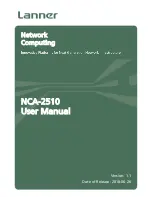
Wireless Networking Basics
D-1
Appendix D
Wireless Networking Basics
This chapter provides an overview of Wireless networking.
Wireless Networking Overview
The FWAG114 wireless firewall conforms to the Institute of Electrical and Electronics Engineers
(IEEE) 802.11b standard for wireless LANs (WLANs) and a product update will bring the
FWAG114 into conformance to the 802.11g standard when it is ratified. On an 802.11b or g
wireless link, data is encoded using direct-sequence spread-spectrum (DSSS) technology and is
transmitted in the unlicensed radio spectrum at 2.5GHz. The maximum data rate for the 802.11b
wireless link is 11 Mbps, but it will automatically back down from 11 Mbps to 5.5, 2, and 1 Mbps
when the radio signal is weak or when interference is detected. The 802.11g auto rate sensing rates
are 1, 2, 5.5, 6, 9, 12, 18, 24, 36, 48, and 54 Mbps. Likewise, the 802.11a wireless link offers a
maximum data rate of 54 Mbps, but will automatically back down to rates 48, 36, 24, 18, 12, 9,
and 6 Mbps.
The 802.11 standard is also called Wireless Ethernet or Wi-Fi by the Wireless Ethernet
Compatibility Alliance (WECA, see
http://www.wi-fi.net
), an industry standard group promoting
interoperability among 802.11 devices. The 802.11 standard offers two methods for configuring a
wireless network - ad hoc and infrastructure.
Summary of Contents for ProSafe FWAG114
Page 4: ...iv ...
Page 20: ...Reference Manual for the ProSafe Dual Band Wireless VPN Firewall FWAG114 2 8 Introduction ...
Page 118: ...Reference Manual for the ProSafe Dual Band Wireless VPN Firewall FWAG114 9 8 Troubleshooting ...
Page 188: ...Reference Manual for the ProSafe Dual Band Wireless VPN Firewall FWAG114 8 Glossary ...
















































